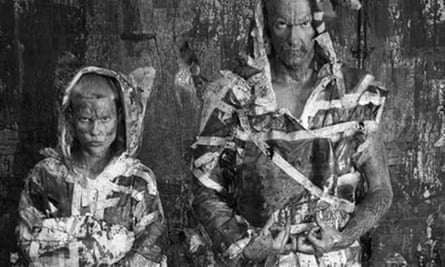Until a month or so ago I'd somehow never heard of Die Antwoord. A friend sent me a link to I Fink U Freeky and it only took a few moments to realise it was the work of director-photographer Roger Ballen. All of Ballen's trademark visuals were there: black and white theatrical sets, a bizarre cast of characters, hieroglyphic scribbles and the occasional animal in peril, in this case a goose. At the centre of all this madness were Ninja and Yo-Landi Vi$$er, members of South Africa's zef rap-rave outfit Die Antwoord, singing and rapping in an almost incomprehensible hybrid of Afrikaans and English. Taken together, the song's music, lyrics and video are an intense alternate universe of grimy magic, as if Samuel Beckett's characters had got a hold of a lot of cheap crystal meth.
Ballen's Die Antwoord: I Fink U Freeky, an exhibition of photographs from the video shoot, opens at Stills Gallery in Sydney this week. It's both an opportunity to ponder Ballen's rather beautiful images without the clatter of the music and to wonder how it is that Ballen's usual style and subject fits so perfectly with Die Antwoord. Of course, Ballen is not the first photographer to direct a music clip, nor is he the first art world figure to put a toe into the world of popular music, but where so many other projects fail, this one is a success.

For the American-born, South African-resident Ballen, the world is a place that one can simultaneously record and fictionalise in a process that the artist refers to as a "documentary fiction". Past series of photographs such as Boarding House and Shadow Chaser were the result of collaborations between Ballen and the urban poor of South Africa.
Whereas convention would require an artist to take on the role of documentarian and dutifully record the reality of a mainly white underclass, Ballen instead worked with his subjects to create a surreal dream world of truncated bodies, baleful looks and unlikely juxtapositions, with the only occasional goose or duck making a cameo. With his career already steeped in Afrikaner subculture, the collaboration with Die Antwoord seems natural.
Few contemporary artists have been able to contend with the music world on its own terms. Melbourne artist Sue Dodd's Gossippop managed to get the mixture of irony and sincerity just right, but parodies such as Danius Kesminas 's Histrionics came off as a lame cover band with joke songs and joke lyrics. Scott Redford's ongoing Reinhardt Dammn project has attempted to put the aesthetics of pop music into an art gallery setting, but has all the life and energy one would expect from such a sentimental attachment to "youth culture". Musicians attempting to hijack the art world, most notably Jay Z's recent appropriation of Marina Ambramovic's performance The Artist Is Present in his endurance performance (and subsequent single) Picasso Baby is much the same: neither comfortably one thing or the other, and, as such, completely disposable.

The suburban mayhem of Die Antwoord's music and video offers its audience provocative contemporary exotica.
Out in the margins of the world, in that contested zone between the West and the imaginary other, there are some truly strange mixtures of styles, politics and aesthetics. But where exotica has always tended to make non-white subjects the alien, in Ballen and Die Antwoord's world it is the white people who are truly strange: the band play with racial and cultural stereotypes, blacking up for videos, adopting alien contact lenses, fake tribal daubing and sign language. Their ability to offend is universal. Die Antwoord offer themselves up as models of a knowing kind of authenticity – how much of this is real? And how much of this is just play-acting?

Comments (…)
Sign in or create your Guardian account to join the discussion